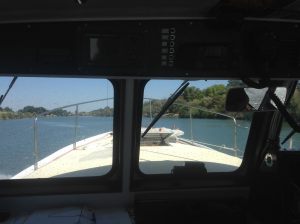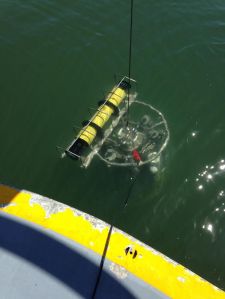Did you know that human waste eventually becomes chemical waste? No, I do not mean that human excretions are so foul, they would be considered chemically hazardous. Nor do I assume that people are flushing radioactive waste down the toilet. However, all people excrete some form of an element called nitrogen in their waste products, which is often converted to ammonium by water treatment plants. Ammonium (NH4+) is a mildly acidic ion1 composed of the elements hydrogen and nitrogen. Everyday we flush nitrogen down the toilet, which is transferred to local water treatment plants and, depending on the treatment used at the plant, is often released into the environment as ammonium.
“What’s the big problem?” you may be tempted to ask. It’s not as if we can control what byproducts we produce! While this is true, complications arise in the way in which some water treatment plants are releasing waste products into local marine systems. Take the treatment plant located in the Sacramento River Delta in California, for example.
Recently, declines in native fish species have sparked an interest in (or, for some, a vendetta against) these treatment plants. Some believe the ammonium that is being released into the environment is disrupting the marine food chain. This ongoing issue has come to be known as the “Great Ammonium Debate.” Proponents of the debate assert that the increased levels of ammonium are causing an overall decline in populations of phytoplankton. Phytoplankton are microscopic marine organisms that rely on sunlight, as well as chemical nutrients like carbon and nitrogen, to photosynthesize and grow. They serve as the smallest fundamental constituents of the marine life food chain, so less phytoplankton means less fish. While it cannot be argued that phytoplankton populations are declining in the area, opponents of the “Great Ammonium Debate” assert that ammonium is not likely the cause.
I sat down to talk with Stanford graduate student Aaron Strong, one of the lead investigators in a university study on the effects of increased ammonium concentrations on phytoplankton populations in the San Francisco Bay and River Delta. On the third weekend of every month, Strong and his team awake at 4:30 am to board a United States geological survey vessel, which travels from south San Francisco Bay near Redwood City to Rio Vista (about seventy miles total) for two days, collecting data. An instrument on the vessel samples water from about a meter below the surface throughout the trip. This water is then processed through a machine that analyzes the concentration of ammonium every one hundred seconds, and another nitrogen compound called nitrate (NO3–). “Having real time data instruments is amazing,” says Strong. “That kind of prediction and instantaneous nature really changes the way we, as scientists, do research.”

On day two of the research trip, the team conducts what Strong calls the “uptake experiments,” in which samples of water containing phytoplankton are taken aboard the vessel and analyzed to determine at what rate phytoplankton absorb ammonium and nitrate ions from the water. The experimental data is collected at different locations around the Bay. One particular location of interest to Strong and his fellow researchers is the diffusion pipe from the treatment plant south of Sacramento. This particular treatment plant releases between ten and fifteen tons of ammonium per day. “Picture this: you have a computer screen and it’s telling you how much ammonium is in the water,” Strong describes to me. “All of a sudden, your boat crosses the diffusion pipe, and [the reading] spikes up a hundred times [relative to its previous level]… that is the amount of ammonium in the water.”

The big question is: What impact does this have on the environment? Phytoplankton need ammonium and nitrate to grow… so, why would a nutrient cause less growth? “It turns out, ammonium, when present at significant concentrations, can prevent nitrate from being utilized from phytoplankton,” Strong explains. Phytoplankton will intake ammonium before nitrate because it is easier for them to process and requires less energy. Strong uses an analogy to illustrate this concept: “Do you want to chew on a hunk of sugar cane, or do you want processed sugar to put in your coffee? The processed sugar is easier.” More and more phytoplankton are now relying on ammonium for their nitrogen intake, instead of nitrate. Paradoxically, the phytoplankton that use nitrate (which also happen to be the key elements of the marine food chain) are becoming scarcer. Scientists have yet to determine the exact cause of this; however, Strong doubts the plankton are growing less because of their switch to ammonium.
Phytoplankton are dying… so the fish are dying, too. “The food web in the bay has collapsed because there are not enough phytoplankton,” asserts Strong. The question nagging on all scientists involved in this collaborative debate is: Why? Some argue that is it due to increased levels of ammonium in the environment. Others speculate that changes to the environment, such as the murkiness of the water, have darkened the water to a point at which phytoplankton can no long sustainably survive.
But Strong has become convinced that the decline in phytoplankton is caused by something completely different. The potomocorbula amurensis (also known as the Asian clam) was introduced to the bay through the exchange of ship ballast water in the bay. “The transition to pelagic2 organism decline was sudden. It was a single year drop in 1986 when the clam entered Suisun Bay. All of a sudden, there were no phytoplankton… and that took place exactly on the same year the clam spread to the bay.” Many scientists in the U.S. geological survey, who have been studying the Bay for decades, also concur with Strong, that the clam is likely the culprit.
This is not the definitive answer to this debate. In fact, most scientists agree that there are multiple causes to the decline in phytoplankton species. “We have a puzzle here: What happened and why did it happen?” Strong tells me. “It’s awesome that there are so many ideas out there. To the extent that people advertise science to nonscientists as solving a mystery, this is the closest you are going to get.”
1 An ion is a chemical compound with an electrical charge. Ammonium (NH4+) has an extra proton that causes its overall charge to be +1.
2 Pelagic organisms are those found in the pelagic zone (also known as the “open-ocean” zone) in bodies of water. Typically the pelagic zone is a little over two miles beneath the surface.
gs: Great Ammonium Debate, ammonium, Sacramento River Delta, phytoplankton, Aaron Strong, nitrate, potomocorbula amurensis, Asian clam